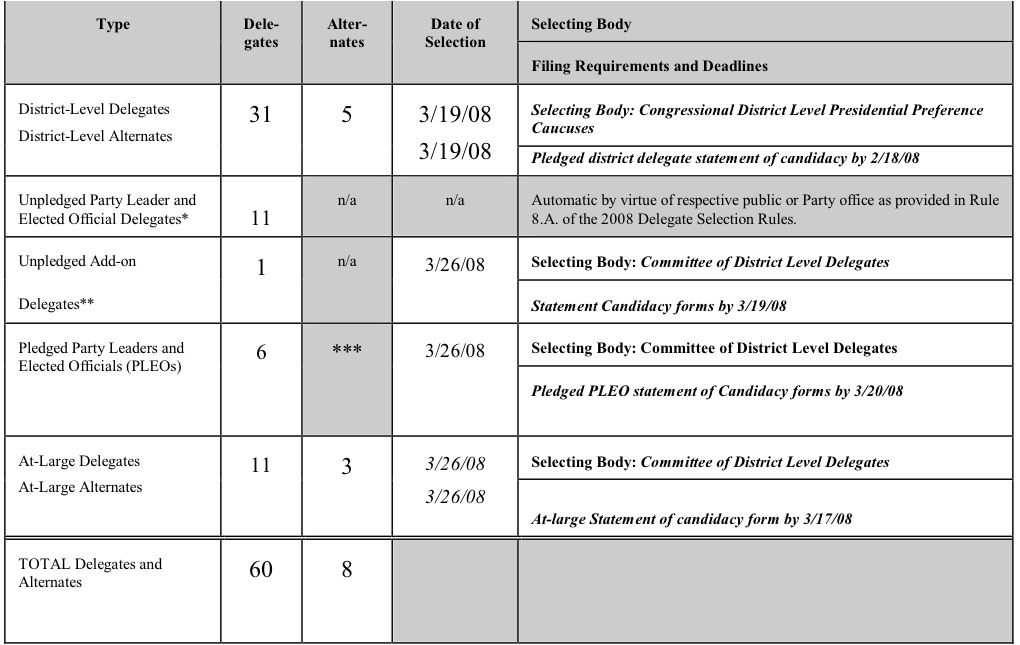A recent commentor asks about the way in which delegates are apportioned in the primaries. I did some digging, and here’s what I found. Start with state law:
Sec. 9-473. Notification by party chairmen of delegates allotted. Not later than the fourteenth day before the day of the primary, the chairman of each party shall certify in writing to the secretary the number of delegates to which such party is entitled pursuant to its rules. If such rules provide that such delegates are to be chosen from districts, the chairman shall also certify the number of delegates allocated to each district and the number to be selected at large, if any. Such rules may (1) prescribe a formula for the allocation of delegates to candidates based upon the percentages of the total votes cast for such candidates at the primary, or (2) require all delegates shall be allocated to the candidate receiving the greatest number of votes notwithstanding such candidate’s percentage of the total votes cast for all candidates. If such rules prescribe a formula for the allocation of delegates to candidates based upon the percentages of the total votes cast for such candidates at the primary, the chairman shall also certify such formula and all information necessary for the application of such formula to the results of the primary. The chairman shall furnish to the secretary, upon request, a written interpretation or explanation of any application of such formula.
As I read this, the state gives the parties the right to allocate votes on an apportioned basis, or hold a winner take all primary. I then went to the Connecticut Democratic Party’s truly awful website, and after following some non-intuitive links, found this pdf (Connecticut Delegate Selection Plan) which sets forth the delegate selection rules. As I understand it from a quick read delegate are chosen on a district level basis, with districts with a higher level of Democratic voters in the last two elections getting more district delegates. The district delegates must accurately reflect the preferences of the voters within that district. This language from the Selection Plan sums it up:
The Connecticut presidential primary election is a “binding” primary. Accordingly, delegate and alternate positions shall be allocated so as to fairly reflect the expressed presidential (or uncommitted) preference of the primary voters in each district. The National Convention delegates and alternates selected at the district level shall be allocated in proportion to the percentage of the primary vote won in that district by each preference, except that preferences falling below a 15% threshold shall not be awarded any delegates or alternates.
So, unless I’m missing something, the district delegates will reflect the percentages in that district. You can probably hypothesize some bizarre circumstances in which a candidate received a disproportionate number of votes (when compared to his or her statewide results) but it seems unlikely that in practice there would be any wildly inappropriate outcomes. It may be that a similar system was the cause for the fact that Obama got more delegates in Nevada (I think it was Nevada) than Hillary, despite his second place showing.
Finally, a candidate must make a threshold showing in order to get any delegates. I.e., if you get 1% of the vote, you are not getting one percent of the delegates. The threshold changes depending on the percentage of the vote obtained by the winning candidate. The default threshold is 15%, but in the case where no one gets more than 15%, the threshold is the percentage obtained by the leading candidate, minus 10%
Connecticut chooses 31 district level delegates. The balance of the delegates include 11 super delegates, and some at large delegates chosen by a committee made up of district level delegates, so presumably the at large delegates should reflect the electoral results, unless by the time they are selected one or more candidates have withdrawn. Here’s a table from the Selection Plan (click to enlarge).
So, to answer the commentor’s ultimate question, a vote for someone other than Hillary or Obama is worth casting, so long as 15% of the voters in your district agree with you.

4 Comments